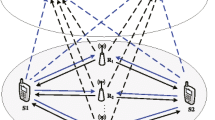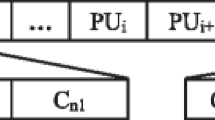Abstract
In this paper, we consider a spectrum sharing cognitive radio (CR) network where a pair of two-way secondary users (SUs) is allowed to coexist with a primary user (PU) as long as the interference power received at the PU is below an acceptable limit. Under the interference power constraint, we investigate the effective capacity region for two-way SUs. In particular, we derive a closed-form solution for the power allocation problem to achieve the boundary points of an inner bound on the effective capacity region. We also propose a key parameter referred to as weighted-transmission-interference-ratio (WTIR), which plays a significant role in the power allocation policy. In the proposed power allocation policy, the exclusive transmission of SUs shall be performed if one SU’s WTIR is much larger than the others. That is, the one with much larger WTIR shall be allocated non-zero power and the other one shall be allocated zero power. Otherwise, if the difference of their WTIRs is not significant, the concurrent transmission shall be performed. That is, both SUs shall be allocated non-zero power. It is shown that a loose interference power constraint leads to the concurrent transmission in most situations, while a stringent interference power constraint leads to the exclusive transmission in most situations. It is also shown that for the stringent interference power constraint and loose delay quality-of-service (QoS) constraint, the proposed power allocation policy is almost optimal and thus the obtained inner bound on the effective capacity region is tight.
Similar content being viewed by others
References
Mitola J, Maguire Jr G Q. Cognitive radio: Making software radios more personal. IEEE Pers Commun, 1999, 6: 13–18
Haykin S, Thomson D, Reed J. Spectrum sensing for cognitive radio. Proc IEEE, 2009, 97: 849–877
Haykin S. Cognitive radio: Brain-empowered wireless communications. IEEE J Sel Areas Commun, 2005, 23: 201–220
Ghasemi A, Sousa E S. Fundamental limits of spectrum-sharing in fading environments. IEEE TransWireless Commun, 2007, 6: 649–658
Musavian L, Aissa S. Capacity and power allocation for spectrum-sharing communications in fading channels. IEEE Trans Wireless Commun, 2009, 8: 148–156
Kang X, Liang Y C, Nallanathan A, et al. Optimal power allocation for fading channels in cognitive radio networks: Ergodic capacity and outage capacity. IEEE Trans Wireless Commun, 2009, 8: 940–950
Kang X, Zhang R, Liang Y C, et al. Optimal power allocation strategies for fading cognitive radio channels with primary user outage constraint. IEEE J Sel Areas Commun, 2011, 29: 374–383
Kang X. Optimal power allocation for fading cognitive multiple access channels: A two-user case. IEEE Wireless Commun Lett, 2013, 2: 683–686
Xu D, Li Q. Ergodic capacity and outage probability optimization for secondary user in cognitive radio networks under interference outage constraint. AEU Int J Electron Commun, 2014, 68: 747–755
Ge Y, Chen M, Sun Y, et al. QoS provisioning wireless multimedia transmission over cognitive radio networks. Multimedia Tools Appl, 2013, 67: 213–229
Aslam S, Lee K G. Spectrum sharing optimization with QoS guarantee in cognitive radio networks. Comput Electr Eng, 2013, 39: 2053–2067
Arshad K, MacKenzie R, Celentano U, et al. Resource management for QoS support in cognitive radio networks. IEEE Commun Mag, 2014, 52: 114–120
Wu D, Negi R. Effective capacity: A wireless link model for support of quality of service. IEEE Trans Wireless Commun, 2003, 2: 630–643
Musavian L, Aissa S. Effective capacity of delay-constrained cognitive radio in Nakagami fading channels. IEEE Trans Wireless Commun, 2010, 9: 1054–1062
Xu D, Feng Z Y, Zhang P. Protecting primary users in cognitive radio networks with effective capacity loss constraint. IEICE Trans Commun, 2012, 95: 349–353
Musavian L, Aissa S, Lambotharan S. Adaptive modulation in spectrum-sharing channels under delay quality-of-service constraints. IEEE Trans Veh Technol, 2011, 60: 901–911
Akin S, Gursoy M C. Effective capacity analysis of cognitive radio channels for quality of service provisioning. IEEE Trans Wireless Commun, 2010, 9: 3354–3364
Akin S, Gursoy M C. Cognitive radio transmission under interference limitations and QoS constraints. In: Proc IEEE International Conference on Communications Conference, Cape Town, 2010. 1–5
Xu Y, Wang J, Wu Q. Effective capacity region of two-user opportunistic spectrum access. Sci China Inf Sci, 2011, 54: 1928–1937
Hammouda M, Akin S, Peissig J. Effective capacity in cognitive radio broadcast channels. In: Proc IEEE Global Communications Conference, 2014. accepted. Available: http://arxiv.org/pdf/1407.4171.pdf
Zhang P, Xu D, Feng Z Y. Capacity of spectrum sharing cognitive radio with MRC diversity under delay quality-ofservice constraints in Nakagami fading environments. KSII Trans Internet Inf Syst, 2013, 7: 632–650
Xu D, Feng Z Y, Zhang P. Effective capacity of delay quality-of-service constrained spectrum sharing cognitive radio with outdated channel feedback. Sci China Inf Sci, 2013, 56: 062311
Alsharoa A, Ghazzai H, Alouini M. Optimal transmit power allocation for MIMO two-way cognitive relay networks with multiple relays using AF strategy. IEEE Wireless Commun Lett, 2014, 3: 30–33
Ubaidulla P, Aissa S. Optimal relay selection and power allocation for cognitive two-way relaying networks. IEEE Wireless Commun Lett, 2012, 1: 225–228
Kang X. Optimal Power allocation for bi-directional cognitive radio networks with fading channels. IEEE Wireless Commun Lett, 2013, 5: 567–570
Aslam S, Shahid A, Lee K G. Reliable, efficient, and power optimized control-channel selection scheme for cognitive radio networks. Math Probl Eng, 2013, doi:10.1155/2013/567581
Lo B F. A survey of common control channel design in cognitive radio networks. Phys Comm, 2011, 4: 26–39
Han X, Chen H, Xie L, et al. Effective capacity region in a wireless multiuser OFDMA network. In: Proc IEEE Global Communications Conference, Anaheim, 2012. 1794–1799
Palomar D P, Chiang M. A tutorial on decomposition methods for network utility maximization. IEEE J Sel Areas Commun, 2006, 24: 1439–1451
Boyd S, Vandenberghe L. Convex Optimization. Cambridge: Cambridge Univ Press, 2004
Author information
Authors and Affiliations
Corresponding author
Rights and permissions
About this article
Cite this article
Xu, D., Li, Q. Effective capacity region and power allocation for two-way spectrum sharing cognitive radio networks. Sci. China Inf. Sci. 58, 1–10 (2015). https://doi.org/10.1007/s11432-014-5247-9
Received:
Accepted:
Published:
Issue Date:
DOI: https://doi.org/10.1007/s11432-014-5247-9




